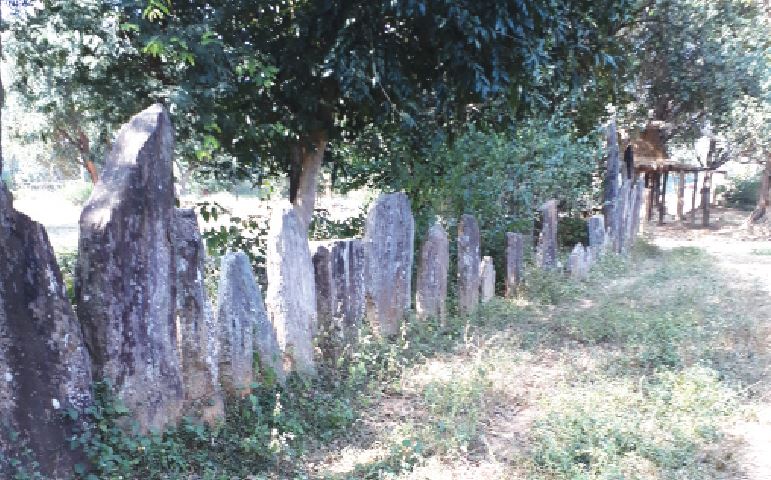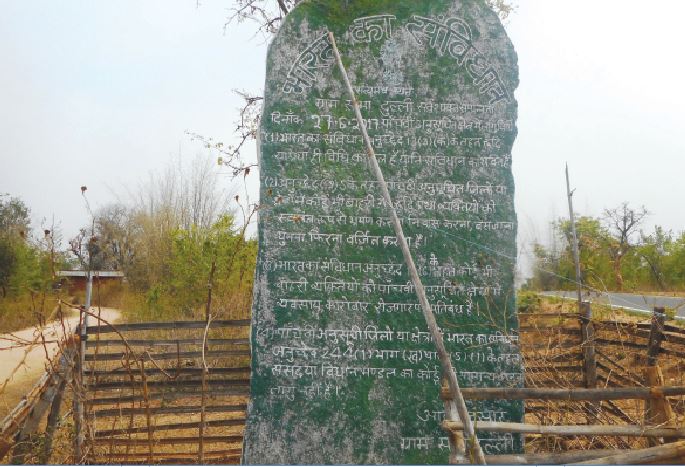
The Sati Pati faith from Gujarat is creating confusion and giving rise to differences in the traditional Munda society in Khunti district post the Pathalgadi movement, reports DEEPANWITA GITA NIYOGI
Baridih is a quintessential Munda village in Khunti, one of the 24 districts of Jharkhand, in eastern India. As guides led the way to the courtyard of a mud house here on a hot afternoon, the murmur of voices could be heard. On entering, a group comprising about 150 people was seen sitting on thin mats spread on the floor. While the women were clad in white sarees, the men sported white kurtas and dhotis.
In the absence of fans, sweat stood like droplets on the foreheads of the participants. A succession of words in Mundari, the language spoken by the Munda tribe, followed. One of the guides informed that the gathering was for celebrating the birth of a newborn. After introductions, one among them, Ramdas Mundu, informed that they were followers of the Sati Pati cult and always wore white. Its members do not avail themselves of government facilities and have boycotted Aadhaar and voter identity cards meant for Indian citizens.
Later at her residence in Khunti, social activist Durgawati Oreya mentioned the strange practices followed by this group. “Can you believe that some couples are breaking up marriages because of this movement imported from Gujarat?” she questioned. Oreya informed that children are being forced to leave schools and people pressurised to close bank accounts. The Sati Pati followers are not practising tribal culture. They are following whatever is being taught in Gujarat, she said.
Deviation from tribal customs
Initially reluctant to converse, AC Arjun of Lamlum in Khunti said there are four families in the village which follow Sati Pati. “We have been following the cult since one year. Followers eat vegetarian food and refrain from alcohol. Some of us do not wear shoes,” he said. Both he and his companion AC Pandu explained that a few people from Khunti had also visited Gujarat six months back. Besides Lamlum and Baridih, the cult has also spread to other villages of the district.
A Khunti-based development professional said on the condition of anonymity that the Sati Pati cult originated around the time when the Pathalgadi movement started in 2017-18 and grabbed national headlines. Basically, people here wanted to assert their land rights through Pathalgadi.
The Pathalgadi movement spread like wildfire in some 70 villages of Khunti. It gathered momentum after the Bharatiya Janata Party government in Jharkhand led by former chief minister Raghubar Das proposed amendments in the Chotanagpur Tenancy Act, 1908 and the Santhal Pargana Tenancy Act, 1949 after winning the 2014 assembly elections. Both the Acts restrict the transfer of tribal lands to non-tribals, but changes were sought to expedite land acquisition.
The state government’s move fuelled suspicion that tribal lands were being acquired for the benefit of private investors and led to massive protests. Jharkhand, carved out of Bihar in 2000 to protect Adivasi interests, has Fifth Schedule areas where the PESA or the Provisions of the Panchayats (Extension to the Scheduled Areas) Act, 1996 seeks to empower gram sabhas or village councils.
In traditional Munda society, pathalgadi is the custom of erecting stone slabs in honour of the deceased or to demarcate boundaries. However, the movement acquired a new meaning when its supporters started erecting huge vertical stone slabs painted in green and inscribed on them sections from the Indian Constitution and PESA.
Lamlum’s headman Etawah Munda, who is of advanced years, explained, “Traditionally stone slabs are erected because these never get destroyed even in rough weather.” Recalling the Pathalgadi movement, he said that as the government was not following PESA, people rose in protest and started erecting stones under the heading India’s Constitution as an act of defiance. The sole motive was to get due recognition for the gram sabha.
As talks continued on Pathalgadi, Arjun informed that followers of Sati Pati do not support the movement. Munda, however, underlined the current tension in the village even though Pathalgadi has softened. “These Sati Pati followers have become distant from us and do not care to attend gram sabha meetings anymore.”
In nearby Rabangdag village, AC Manohar informed that Sati Pati actually originated around 2015 in Khunti. It was a hidden thing which slowly came out in the open. In his village, there are 28 families following the cult at present. “We follow the ruling of nature and invoke the five elements morning and evening. We neither worship the Sal tree like tribals nor celebrate Sarhul during spring.”
All the three followers have inserted the word AC before their names. Explaining its meaning, Arjun pointed out that AC stands for Ante Christum Natum or before the birth of Christ. “The cult followers have been living here even before Christ was born. Being the original owners of the country, we do not want any facility from the Government of India as we are not Indian citizens. Citizens are outsiders,” Arjun added.
The Gujarat connection
The Sati Pati cult, which has spread to parts of Madhya Pradesh and Chhattisgarh, originated in pre-independence India. Gujarat-based writer Jitendra Vasava informed about a village called Kataswan in Tapi district where there are Sati Pati followers. Initially, a person named Gulia Bhil started a movement in 1937 in Khandesh (a region in central India) to introduce the concept of respect in the community which was carried forward by his brother Ramdas. Many Bhils joined the movement as they were looked down upon by other communities. But the Sati Pati movement in its present form was given shape around 1941-42 by Keshri Singh under the name of AC Kutumb Parivar, which declared to be the real owner of India. Singh started spreading the movement among the people.
“The Sati Pati followers think that the Earth should not be ploughed throughout the year. Many of its ideals cannot be accepted today by educated tribals. Also, Pathalgadi as a tradition is thousands of years old and so many people do not follow Sati Pati,” Vasava, who has been working with the Bhil community since 2006-07, said.
Gujarati tribal social worker Ashok Chaudhuri explained that zamindars or land owners used to exploit Adivasi women in colonial times. As society was disintegrating, the idea of Sati Pati was started to instil respect for each other among married couples. “It also upheld the question of Adivasi identity as doubts surfaced regarding the future of tribals after India’s independence,” he said.
Speaking about identity, a Ranchi-based professor said the idea that they are the original inhabitants of India has penetrated so deep that Sati Pati followers have thrown away government documents. He added that in Khunti, some of them are talking about minting their own currency, besides making illogical statements. The movement spread as Kunwar Singh’s family wanted to be all powerful.
In Kumkuma village, amidst the din of a tribal Christian wedding ceremony, Sukhram Munda said Pathalgadi sought to assert tribal identity in a big way. But he conceded that Sati Pati is now disintegrating the Adivasi society. “It’s a secret which is still to be fathomed. These people are being told to act as change makers. They are trying to script a new history but won’t be able to do it in the long run. Their brains have been totally washed.”

Tribal identity versus Sati pati
After current chief minister Hemant Soren of the Jharkhand Mukti Morcha came to power in December 2019, he declared the withdrawal of cases and dropping of sedition charges filed against Pathalgadi supporters. A non-tribal politician based in Khunti, who did not wish to be named, informed that this will further embolden the supporters who may renew the movement in future. He also said that the Bharatiya Janata Party may have fanned the Pathalgadi movement by blaming it on missionaries to garner tribal votes.
Besides assertion of land rights, other theories behind Pathalgadi’s origin have been advanced. A police official, who was once posted in Khunti, explained that a large number of people got involved in opium cultivation and started Pathalgadi as a frontal cell organisation. “The People’s Liberation Front of India, an offshoot of militant organisation, the CPI (Maoist), also had a hand behind this. The intent was to keep the police and the district administration out of bounds.” But Mrinalini Adela Tete, an advocate in the Jharkhand high court, said as Khunti is the birthplace of freedom fighter Birsa Munda, the sense of tribal identity is naturally strong here. Outsiders wanted to grab land for development. So, they planted the opium story, she added.
Union minister for tribal affairs Arjun Munda said that the Pathalgadi movement had misused the age-old Munda tradition of erecting stone slabs in honour of the dead. “Efforts are being made to make people bewildered. Our ministry thinks that based on the Constitution, there should be welfare of tribal communities in villages, and that traditional customs like Pathalagdi kept intact,” the minister said over phone.
The Pathalgadi movement was brutally dealt with by the state. A few villagers denied interaction with the reporter back in 2019 during the assembly election campaign due to fear. The professor, however, feels that Satipati followers in Khunti are now trying to play safe. Thus, their natural inclination is to distance themselves from the movement.
Amidst all the blame game, Ranchi-based tribal activist Aloka Kujur admitted the influence of Hindutva on the Sati Pati cult. “Not observing Adivasi festivals and developing a different tradition signifies that these people are going in a different direction. Incidentally, Sati Pati is spreading at a time when tribals are demanding the Sarna religious code.” Kujur also questioned the intention of the cult followers in not keeping land records. Adivasis consider land as their most important asset. “By creating confusion, the cult members want to give birth to a new form of capitalism in the tribal society. In this, their attitude is similar to Hindutva organisations,” she added.
The story has been produced in collaboration with the Pulitzer Center for Crisis Reporting
tehelkaletters@gmail.com













